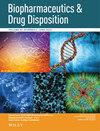Physiologically based pharmacokinetic modeling and simulations to inform dissolution specifications and clinical relevance of release rates on elagolix exposure
IF 2
4区 医学
Q3 PHARMACOLOGY & PHARMACY
引用次数: 3
Abstract
The aim of this analysis was to use a physiologically based pharmacokinetic (PBPK) model to predict the impact of changes in dissolution rates on elagolix exposures and define clinically relevant acceptance criteria for dissolution. Varying in vitro dissolution profiles were utilized in a PBPK model to describe the absorption profiles of elagolix formulations used in Phase 3 clinical trials and for the to be marketed commercial formulations. Single dose studies of 200 mg elagolix formulations were used for model verification under fasted conditions. Additional dissolution scenarios were evaluated to assess the impact of dissolution rates on elagolix exposures. Compared to the Phase 3 clinical trial formulation, sensitivity analysis on dissolution rates suggested that a hypothetical scenario of ∼75% slower dissolution rate would result in 14% lower predicted elagolix plasma exposures, however, the predicted exposures are still within the bioequivalence boundaries of 0.8–1.25 for both Cmax and AUC. A clinically verified PBPK model of elagolix was utilized to evaluate the impact of wider dissolution specifications on elagolix plasma exposures. The simulation results indicated that a slower in vitro dissolution profile, would not have a clinically significant impact on elagolix exposures. These model results informed the setting of wider dissolution specifications without requiring in vivo studies.基于生理学的药代动力学建模和模拟,以告知依拉哥利暴露的溶出规格和释放率的临床相关性
该分析的目的是使用基于生理学的药代动力学(PBPK)模型来预测溶出率变化对依拉哥利暴露的影响,并确定临床相关的溶出接受标准。在PBPK模型中利用不同的体外溶出谱来描述3期临床试验中使用的依拉哥利制剂和即将上市的商业制剂的吸收谱。在禁食条件下,对200mg依拉哥利制剂进行单剂量研究,用于模型验证。对其他溶出情况进行了评估,以评估溶出率对elagolix暴露的影响。与3期临床试验制剂相比,对溶出率的敏感性分析表明,溶出率降低约75%的假设情况将导致预测的依拉哥利血浆暴露量降低14%,然而,Cmax和AUC的预测暴露量仍在0.8–1.25的生物等效性范围内。采用经临床验证的elagolix PBPK模型来评估更广泛的溶出规格对elagoliz血浆暴露的影响。模拟结果表明,较慢的体外溶出曲线不会对elagolix暴露产生临床显著影响。这些模型结果为设定更广泛的溶出规格提供了依据,而无需进行体内研究。
本文章由计算机程序翻译,如有差异,请以英文原文为准。
求助全文
约1分钟内获得全文
求助全文
来源期刊
CiteScore
3.60
自引率
0.00%
发文量
35
审稿时长
6-12 weeks
期刊介绍:
Biopharmaceutics & Drug Dispositionpublishes original review articles, short communications, and reports in biopharmaceutics, drug disposition, pharmacokinetics and pharmacodynamics, especially those that have a direct relation to the drug discovery/development and the therapeutic use of drugs. These includes:
- animal and human pharmacological studies that focus on therapeutic response. pharmacodynamics, and toxicity related to plasma and tissue concentrations of drugs and their metabolites,
- in vitro and in vivo drug absorption, distribution, metabolism, transport, and excretion studies that facilitate investigations related to the use of drugs in man
- studies on membrane transport and enzymes, including their regulation and the impact of pharmacogenomics on drug absorption and disposition,
- simulation and modeling in drug discovery and development
- theoretical treatises
- includes themed issues and reviews
and exclude manuscripts on
- bioavailability studies reporting only on simple PK parameters such as Cmax, tmax and t1/2 without mechanistic interpretation
- analytical methods

 求助内容:
求助内容: 应助结果提醒方式:
应助结果提醒方式:


